November 11, 2024
Christmas Plants: How to Keep Your Holiday Greens Happy
Nothing brings the holiday spirit quite like the beauty of Christmas plants. From the vibrant reds of poinsettias to the delicate blooms of Christmas cactus and the graceful green branches of Norfolk Island pine, these plants add warmth, charm, and cheer to any home. Here’s a guide on caring for these festive favorites, so they stay healthy and beautiful throughout the season and beyond.
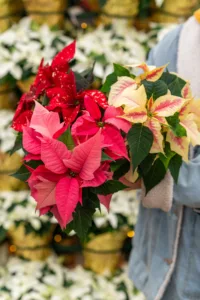
Poinsettias: The Classic Christmas Flower
Poinsettias are a holiday favorite, known for their striking red leaves (called bracts) and lush green foliage. They’re perfect for adding a splash of color to any room!
How to Care for Your Poinsettia:
- Light: Place your poinsettia in a spot with bright, indirect sunlight. A window with morning sun is ideal.
- Watering: Water when the top two inches of soil is dry. Allow water to drain away to avoid soggy roots, which poinsettias don’t like.
- Temperature: Keep your plant in a warm room, ideally around 65-75°F, and away from cold drafts or direct heat sources.
- Pet & Child Safety: Contrary to popular belief, poinsettias aren’t as toxic as once thought. While not recommended for snacking, they’re generally safe around pets and children, though they may cause mild discomfort if ingested.
Fun Fact: Poinsettias are native to Mexico, and their original bright red color has been joined by new varieties, including whites, pinks, and even speckled designs.
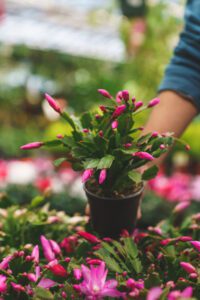 Christmas Cactus: The Blooming Winter Wonder
Christmas Cactus: The Blooming Winter Wonder
Known for its beautiful, cascading blooms that appear during the winter months, the Christmas cactus is a unique holiday choice. Its vibrant flowers add a pop of color during a time when most other plants are dormant.
How to Care for Your Christmas Cactus:
- Light: Place it in bright, indirect light. Avoid direct sunlight, which can burn its leaves.
- Watering: Water when the soil is dry to the touch. Over-watering can cause root rot, so be mindful to let the soil dry a bit between waterings.
- Encouraging Blooms: For the best chance of winter blooms, reduce the plant’s light exposure in the fall (around October) and place it in a cooler room at night. These conditions help trigger flowering just in time for Christmas.
Tip: The Christmas cactus is easy to share! You can propagate it from cuttings, making it a perfect gift for friends and family during the holiday season.
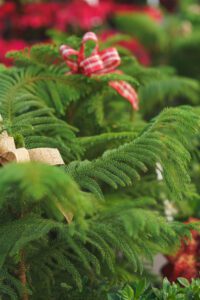 Norfolk Island Pine: A Mini Christmas Tree
Norfolk Island Pine: A Mini Christmas Tree
With its soft, needle-like branches, the Norfolk Island pine is a popular alternative for those who want a mini Christmas tree. It’s perfect for decorating with small ornaments and string lights, bringing a festive touch to even the coziest spaces.
How to Care for Your Norfolk Island Pine (you can also check out our blogpost on the topic for more detail!):
- Light: Norfolk Island pines need bright, indirect light. A well-lit room is ideal.
- Watering: Keep the soil consistently moist but not soggy. Water when the top layer begins to feel dry, and make sure your pot has good drainage.
- Humidity: These pines love humidity! If your home tends to be dry during winter, especially with indoor heating, mist the plant regularly or place a humidifier nearby to keep it thriving.
Decorating Tip: Since Norfolk pines are slow-growing, you can keep and enjoy them for many holiday seasons to come. Add lightweight ornaments to avoid weighing down the branches, and enjoy your own miniature tree.
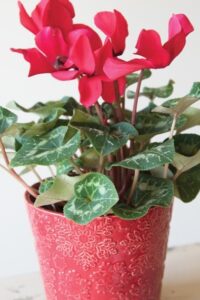 Cyclamen: The Winter Bloomer
Cyclamen: The Winter Bloomer
Cyclamen plants are known for their delicate, butterfly-like blooms in shades of pink, red, white, and purple. With their unique marbled leaves, cyclamen make a beautiful addition to holiday decor, bringing a fresh and cheerful look to any indoor space.
How to Care for Your Cyclamen:
- Light: Place cyclamen in bright, indirect light, but avoid direct sunlight as it can be too intense for their delicate blooms.
- Watering: Keep the soil evenly moist, but be cautious not to overwater. Water from the base by placing the pot in a shallow dish of water and letting the plant absorb what it needs for a few minutes. Avoid getting water on the leaves and crown to prevent rot.
- Temperature: Cyclamen thrive in cooler temperatures (around 60-65°F). Avoid placing them in overly warm rooms, as they prefer the chill of winter to bloom their best.
- Dormancy: After the blooming period, cyclamen often go dormant. Don’t be alarmed if the leaves yellow and die back. Reduce watering, and store the plant in a cool, dark place until new growth begins in late summer or early fall.
Tip: Cyclamen can rebloom year after year! Just give them a cool rest period after flowering, and they’ll reward you with fresh blooms next winter.
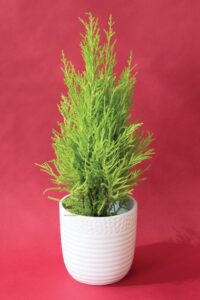 Lemon Cypress: The Festive, Fragrant Evergreen
Lemon Cypress: The Festive, Fragrant EvergreenGeneral Tips for Holiday Plant Care
- Avoid Direct Heat & Cold Drafts: Place holiday plants away from heating vents, fireplaces, or drafty doors. Sudden temperature changes can stress the plants.
- Watch the Watering: Plants need less water in winter, so be cautious not to overwater. Check soil moisture first.
- Add Some Fertilizer (After the Holidays): Once the holiday season is over, consider adding a balanced fertilizer in spring to support new growth for the next year.
These festive plants don’t just add beauty to your holiday decor; they can be a lasting part of your indoor garden with a little care. So go ahead and bring the spirit of the season into your home with poinsettias, Christmas cactus, and Norfolk pines – and enjoy the warmth they add all winter long.
And if you’d like to listen to our Greenhouse Expert, Farid, talk about this topic with our friend Maria from Growing Joy with Plants Podcast, click below! You can also come visit us at any of our 7 locations for in-person advice!
